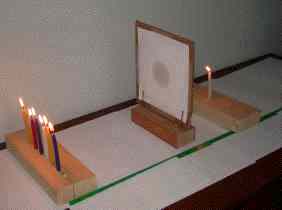|
This remarkably simple 19-th century optical experiment can confirm that, indeed, the intensity of light decreases like 1/R2 , where R is the distance from the source.
It also drives home the fact that physical measurements are often comparisons to a standard. A two-pan balance does not measure weight--it compares it to that of a set of standard weights. A surveyor compares distances to a baseline, a Wheatstone bridge compares electric resistances to a given resistance standard, and so on. Here you compare the brightness of pairs of light sources, with intensity ratios 1:1, 1:2, 1:3 etc.

You will need (Note: in the picture here, the dark spot in the middle of the screen does not represent the true operation of the photometer, but was unavoidable when using a camera flash.) Alternatively (to avoid working with open flames)
With a tiny dab of oil, butter or margarine, make a round grease spot in the middle of the paper. The spot should be translucent: some light can pass through other parts of the screen, too, but much more shines through where the spot is. The single candle (or lightbulb) is raised at one end, the multiple light sources on the other end (they should be lined up perpendicular to the direction of the yardstick, at the same height as the grease spot). The block with the paper screen should be placed between them, with the screen also perpendicular to the direction of the yardstick. A pen mark on the block should allow you to measure the distances (R1, R2) from the screen to the (single, multiple) light sources. The experiment is best performed in a moderately dark room and makes a nice classroom demonstration.
Let us assume the white paper reflects 94% the light, letting through only 6%; the spot lets through more, say 38%, reflecting only 62% (any other numbers will do just as well). Because less light is reflected from the spot, it looks darker. Seen from the side far from the candle, the spot is bright, because light is coming through it. Outside the grease spot, only 6% of the light intensity manages to shine through the paper; inside the spot, 38% does. Light another candle or bulb on the other side and move the screen up and down the yardstick. As it approaches either end, the spot looks dark from that side, bright from the other. But in the middle, there exists one distance at which the spot disappears. Make sure: it should disappear (or anyway, have the same appearance) when seen from both sides. At that distance, each side is illuminated with the same intensity. On each side, 38% of the arriving light passes through, but that is exactly balanced by 38% of the light from the other side emerging from the spot. Whatever the percentages--both sides are illuminated with equal brightness, the light going out through the translucent spot exactly equals the light coming in from the other side. So the spot disappears.
That at distance R from a light source which has strength S (for "source"), the light intensity is proportional to
This is true in whatever units we measure the strength S of the source. For our convenience, let S be measured in "candles" or "lightbulbs", making it equal to the number N of light sources used (below, we use "candles"). In those units, When the spot disappears, we expect I1 = I2, and we get R1 = R2 . The screen should be in the middle. Light one more candle, giving 2 candles on one side. On that side
To make intensities equal, it becomes necessary to move the screen closer to the single candle. Then Next repeat with 3, 4... candles on one side. With 3 candles, following the same steps and so forth. You can draw a graph, with
y = (R2 / R1) 2 (ratio for that number of candles) and should get a straight line y=x, at 45 degrees to each axis. |